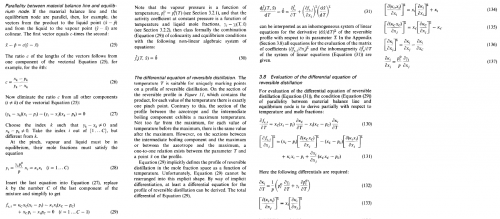-
Posts
33 -
Joined
-
Last visited
About TokenMonkey
- Birthday 03/15/1987
Profile Information
-
Location
South Africa
Retained
- Quark
TokenMonkey's Achievements

Quark (2/13)
10
Reputation
-

Implementation of psuedo-arclength continuation
TokenMonkey replied to TokenMonkey's topic in Applied Mathematics
I found the answer: a procedure is described in Kubicek's Algorithm 502 in ACM Trans. Math. Software. dl.acm.org/citation.cfm?id=355675 -
Hi there, I have a quick question regarding pseudo-arclength continuation. As some background, I am a chemical engineer, not a mathematician, applied or otherwise, so my knowledge of numerical methods is limited to the "standard" stuff. I've been reading up as extensively as I can on pseudo-arclength continuation, but unfortunately, it's all from second-hand sources; I don't have access to Keller's original paper. Here's what I understand at this point: We want to solve a problem [math]F(x,\lambda)=0[/math]. We assume that the solution is known at [math]x^0[/math] and [math]\lambda^0[/math]. To avoid the singularity of the Jacobian, and therefore the breakdown of Newton's method, at turning points, [math]x[/math] and [math]\lambda[/math] both become parameterised by arclength ([math]s[/math]), and we end up with an augmented system of equations to solve: [math]F(x,\lambda)=0[/math] [math]\left(u-u^{0}\right)\mathrm{d}u^{0}/\mathrm{d}s+\left(\lambda-\lambda^{0}\right)\mathrm{d}\lambda^{0}/\mathrm{d}s-\Delta S=0[/math] While this seems simple enough, how does one obtain the derivatives w.r.t [math]s[/math]? Not a single text seems to mention this. Ideas that spring to mind are forward differences using, say, cubic splines; however, that seems horrendously inefficient to me. There must be a better way! Thanks, TM
-
Thanks for the reply. The system I'm considering can definitely be linearized at the fixed points, so that will work fine. I haven't got access to the book you mentioned, but I did find a nice summary (again, for 2-D systems) in James Robinson's "An Introduction to Ordinary Differential Equations" (Cambridge University Press). To clarify my question further, what if, for example, you look at the eigenvalues in a 4-D system, two of which are real and > 0, and two of which are complex conjugates of each other, with real parts < 0. The real parts would then dictate that it is a saddle, but that combination (mixture of real and complex) isn't covered by any 2-D case. Is it then a special type of saddle? I hope that makes sense! If not, I'll try to clarify even more.
-
I'm familiar with the classification of fixed points of linear dynamical systems in two dimensions; it's readily available in many a book, as well as good ol' Wiki (http://en.wikipedia.org/wiki/Linear_dynamical_system#Classification_in_two_dimensions). However, what happens with higher-order systems, say, three-dimensional? In that case, you'll end up having three eigenvalues -- presumably, different combinations of their signs give rise to different fixed point types. Has this been investigated? I've looked at numerous books, and all I ever seem to find is classification for two dimensions. Any help with finding a book/paper/URL dealing with this would be much appreciated!
-
Haha, I did notice, but I wasn't about to go nitpicking with someone who was trying help me.
-
Thanks, Timo. I guess that that's what it must mean. Still, it's a weird, weird way of expressing a simple concept.
-
Hi all, I hope this is the right forum to post this question in, rather than one of the subforums, as it deals with notation, not actual mathematics. I've attached a pic of the problem I'm looking at: In Eq. (31), an implicit ODE is given; note how the last two derivatives are superscripted with a summation/capital sigma. What does this mean? I've Googled as best I can, but no luck. The only clue I have is that one of the terms superscripted with the sigma is a matrix of coefficients. There are more examples of this notation later on in the attachment. Any thoughts on this? Even a pointer in the right direction would be helpful. Thanks, TM
-

Parameterising a trajectory to pass through fixed points
TokenMonkey replied to TokenMonkey's topic in Mathematics
Thanks for the reply, D H. I've been using optimisation thus far (both the toolbox (patternsearch, specifically) and fminsearch), and it works OK, except that (a) that approach is slow, because it's a sort of "brute force" method where it calculates a trajectory at every iteration of the optimisation, but more importantly (b) it doesn't seem to find the global minimum, but a local one, so that the solution to which it converges is remarkably sensitive to the initial guess. I don't think I explained that very well, but suffice it to say that it's rather clumsy and I'm hoping for something more elegant than that, which will hopefully either be quicker so that I can try many initial guesses, or that it'll find the global optimum the first time round. I'll keep going with the optimisation route so long and see what I can do with it, but it just strikes me as odd that I can't find much (any!) info on this type of problem. -
Hi, all! Google's turned up nothing relevant (except my post of the same thing on another non-SFN forum) to help me with this problem. I'm at a bit of a loss as to how to do the following elegantly—I've had some success with a slow, "nested" optimisation for what I'm trying to do, but I'm not happy with the results. I have a trajectory described by: [math]\frac{{dx}}{{d\tau}} = f(x,y,a,b,c)[/math] [math]\frac{{dy}}{{d\tau}} = g(x,y,a,b,c)[/math] where [math]a[/math], [math]b[/math], and [math]c[/math] are parameters. The functions [math]f[/math] and [math]g[/math] cannot be calculated analytically (iteration is required), but what happens internally is unimportant anyway, I think. If I select values for these parameters, I can plot a trajectory in the [math]x[/math]-[math]y[/math] space. What I'm trying to do is find out which combinations of parameters [math]a[/math], [math]b[/math], and [math]c[/math] will make the trajectory pass through two fixed points, say [math](x_1,y_1)[/math] and [math](x_2,y_2)[/math]. Of course, this will more than likely lead to many solutions to the problem, and I will choose a set of parameters that minimises another function, say [math]h(x_1,y_1,x_2,y_2,a,b,c)[/math]. Does anyone have any idea how I'd go about finding appropriate combinations of parameters? My weapon of choice is MATLAB, in case that happens to have built-in functions for what I need. Any help, or even just a pointer in the right direction, would be greatly appreciated. This must have been done before by someone somewhere; I just have no idea what the principle is called. Thanks! TokenMonkey
-
An old, but still very good, book on the topic of heat exchanger design is "Process Heat Transfer" by D. Q. Kern. If you can find a copy, have a look. That should have everything you need.
-

Need help with Thermodynamics question...
TokenMonkey replied to TokenMonkey's topic in Homework Help
My plan of attack was this: An energy balance on A will reveal dU + PdV = dQ. Integrating that whole lot and using dU = CvdT, I should get Q, not so? HOWEVER, the issue arises in trying to calculate the PdV term in B (or A for that matter). W = ∫PdV, where P = nRT/V. Great, except for the fact that T isn't constant... How do I account for this in the integration? -

Need help with Thermodynamics question...
TokenMonkey replied to TokenMonkey's topic in Homework Help
Seeing as [math]\gamma[/math] cannot be determined with the given information, I'm sure there is a way to do it without, I'm just not quite sure how... -

Need help with Thermodynamics question...
TokenMonkey replied to TokenMonkey's topic in Homework Help
Damn... So without knowing what gas is in question (or at least whether it's monoatomic or diatomic), I have no real way of determining what [math]\gamma[/math] is? -

Need help with Thermodynamics question...
TokenMonkey replied to TokenMonkey's topic in Homework Help
A-ha, so that (and Wikipedia) would lead me to believe that for an ideal gas, I can use [math]\gamma = \frac{5}{3}[/math]... Correct? -

Need help with Thermodynamics question...
TokenMonkey replied to TokenMonkey's topic in Homework Help
A-ha, so my belief is a lie! Umm... I could have sworn I read it in some notes somewhere, but chances are I remembered that statement and not the conditions which make the statement true! I thought it was a bit sketchy, but it was a convenient simplifier, not so? Hehe... Anyway, that aside, what "If the cylinder and piston are heat insulators with negligible heat capacity ..." tells me is that compartment B is adiabatic, so the energy added by the heater will not directly affect it, only indirectly. The only work done on it is P-V work of its compression. However, before I can even start thinking about that, I need to solve the first part, which is the conditions in compartment B... I still need to know one more variable... I need to work out either VA, VB or TB somehow. Is there any way I can relate the pressure in A before the heating to the pressure in A after the heating? That would be of immense help.


